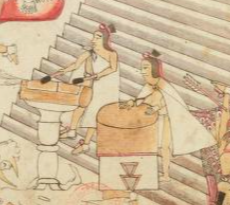teponaztli (Azca29)
This painted black-line drawing is an unglossed iconographic example of a horizontal log drum (which we are labelling teponaztli here). A man in a three-quarter view and wearing a white cape is playing the drum. He plays the drum with two wooden sticks. The part of the sticks that hits the drum seems to have some kind of black covering over it. The drummer has a clump of hair tied with a red (probably leather) thong on top of his head. This style might be a tzontli. The drum sits on a tall, elaborate pedestal, which might show European stylistic influence. The drum has an H-shaped slit that creates two panels for pounding.
Stephanie Wood
One of the examples of a teponaztli from the Codex Mendoza shows it sitting on a round, twisted reed base (possibly called a yahualli). Another shows a ladder-like structure (see the huehuetzotzonqui). This might have an earlier origin, given the many ladder-like structures in Nahua glyphs, such as the cacaxtli, ecahuaztli, and huacalli, among others. (Examples of these can be searched in the Quick Search in this collection.)
Stephanie Wood
post-1550, possibly from the early seventeenth century.
Jeff Haskett-Wood
tambores, música, madera, tecnología
teponaz(tli), horizontal log drum, https://nahuatl.wired-humanities.org/content/teponaztli
el tambor horizontal
Stephanie Wood
The Codex Azcatitlan is also known as the Histoire mexicaine, [Manuscrit] Mexicain 59–64. It is housed in the Bibliothèque Nationale de France, and hosted on line by the World Digital Library and the Library of Congress, which is “unaware of any copyright or other restrictions in the World Digital Library Collection.”
https://www.loc.gov/resource/gdcwdl.wdl_15280/?sp=29&st=image
The Library of Congress is “unaware of any copyright or other restrictions in the World Digital Library Collection.” But please cite Bibliothèque Nationale de France and this Visual Lexicon of Aztec Hieroglyphs.


